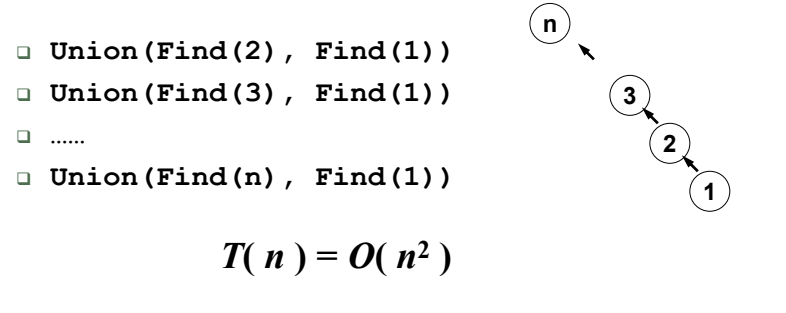之前我们介绍了并查集,但是我们可以进行简化,使得并查集的效率更高
原先并查集的缺点
//原来的并查集代码
typedef struct {
ElementType Data;
int Parent;
} SetType;
int Find( SetType S[], ElementType X )
{
int i;
for ( i=0; i<MaxSize && S[i].Data!=X; i++ ) ;//最坏的情况,这里要将所有的元素查找一遍
if ( i>=MaxSize ) return -1;
for( ; S[i].Parent>=0; i=S[i].Parent ) ;
return i;
}
优化
任何有限集合的(N个)元素都可以被一一映射为整数 0 ~ N–1
typedef int ElementType; /*默认元素可以用非负整数表示*/
typedef int SetName; /*默认用根结点的下标作为集合名称*/
typedef ElementType SetType[MaxSize];
SetName Find( SetType S, ElementType X )
{ /* 默认集合元素全部初始化为-1 */
for ( ; S[X]>=0; X=S[X] ) ;
return X;
}
void Union( SetType S, SetName Root1, SetName Root2 )
{ /* 这里默认Root1和Root2是不同集合的根结点 */
S[Root2] = Root1;
}
按秩归并
为什么要按秩归并
按原本的归并方法,旧结点是归并到新结点上的,那么最坏的情况下就会如下

显然这样效率不高。因此集合的归并应该是小集合归并到大集合上。
集合的比较可以根据
1、 树的高度
2、 集合的规模
按秩归并后的代码
//树的高度
if ( S[Root2] < S[Root1] )
S[Root1] = Root2;
else {
if ( S[Root1]==S[Root2] ) S[Root1]--;
S[Root2] = Root1;
}
//集合的规模
void Union( SetType S, SetName Root1, SetName Root2 )
{
if ( S[Root2]<S[Root1] ){
S[Root2] += S[Root1];
S[Root1] = Root2;
}
else {
S[Root1] += S[Root2];
S[Root2] = Root1;
}
}
路径压缩
SetName Find( SetType S, ElementType X )
{
if ( S[X] < 0 ) /* 找到集合的根 */
return X;
else
return S[X] = Find( S, S[X] );
}
return S[X] = Find( S, S[X] )有三个操作
1.先找到根;
2.把根变成 X 的父结点;
3.再返回根。
优化后的代码
#define MAXN 1000 /* 集合最大元素个数 */
typedef int ElementType; /* 默认元素可以用非负整数表示 */
typedef int SetName; /* 默认用根结点的下标作为集合名称 */
typedef ElementType SetType[MAXN]; /* 假设集合元素下标从0开始 */
void Union( SetType S, SetName Root1, SetName Root2 )
{ /* 这里默认Root1和Root2是不同集合的根结点 */
/* 保证小集合并入大集合 */
if ( S[Root2] < S[Root1] ) { /* 如果集合2比较大 */
S[Root2] += S[Root1]; /* 集合1并入集合2 */
S[Root1] = Root2;
}
else { /* 如果集合1比较大 */
S[Root1] += S[Root2]; /* 集合2并入集合1 */
S[Root2] = Root1;
}
}
SetName Find( SetType S, ElementType X )
{ /* 默认集合元素全部初始化为-1 */
if ( S[X] < 0 ) /* 找到集合的根 */
return X;
else
return S[X] = Find( S, S[X] ); /* 路径压缩 */
}